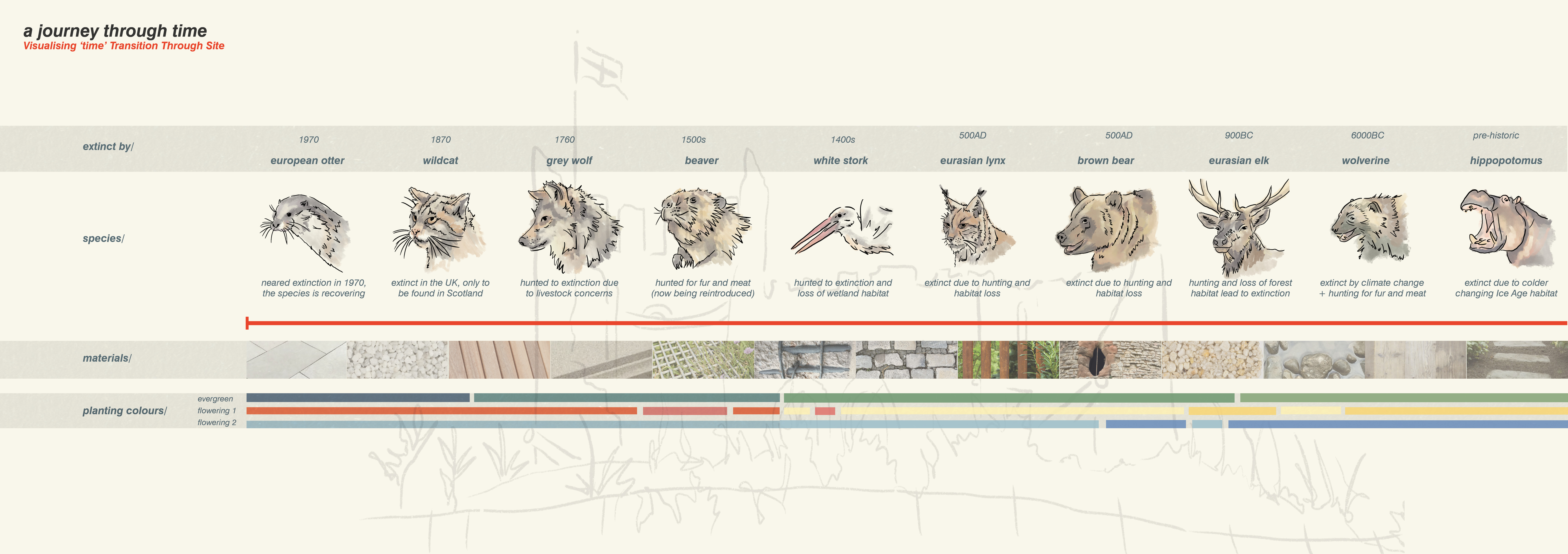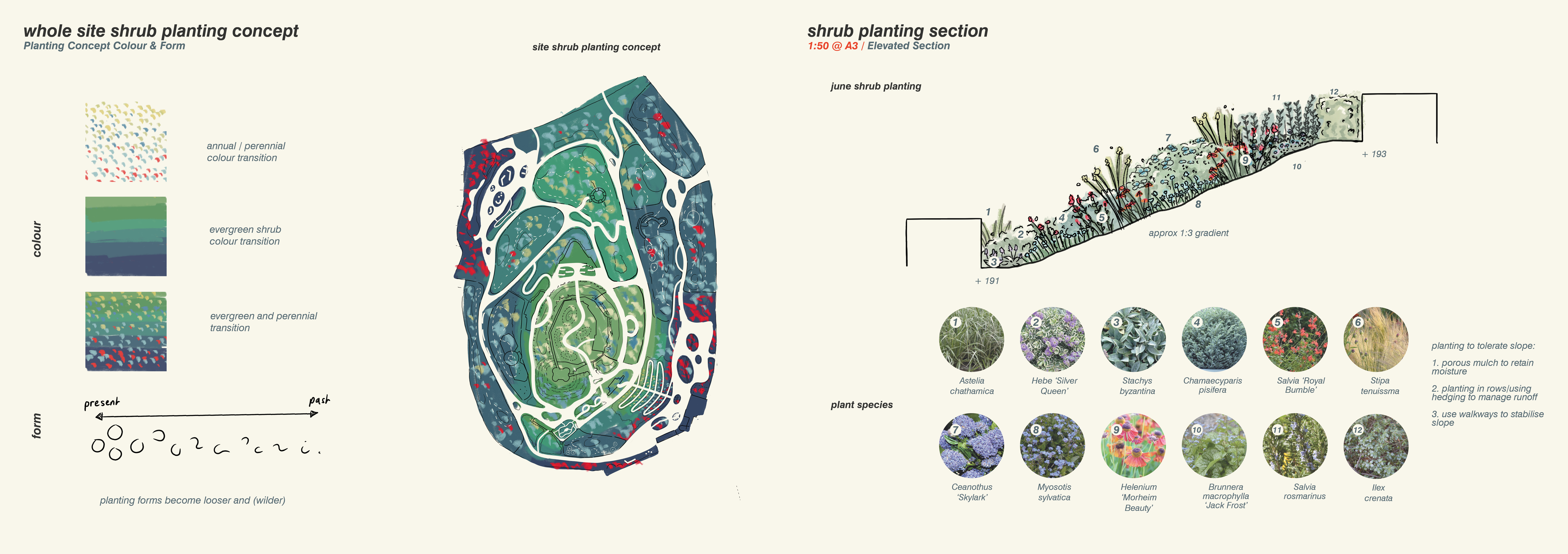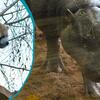Using Dudley Zoo and Castle’s historic architecture, Abby Staniland details a landscape proposal to showcase the past and future of the natural world…
Could a zoo become an immersive storybook of local, natural history? By prioritising education, conservation, ecology and heritage, can zoo landscape design allow visitors to experience the natural past, present and future of the site in one streamlined educational journey?
‘The Zoo of Time’ is a landscape proposal to conserve the past, present and future at Dudley Zoo & Castle creating an immersive, narrative landscape, forming a keystone area for the reintroduction of UK native ecology.
My final BA Landscape Architecture project re-imagines the existing Dudley Zoo & Castle which currently features layers of architectural history such as the 11th century castle and Grade 2 listed ‘Tecton’ animal enclosures from the 1930s. Through accessible landscape design, I aim to re-invent the narrative and aims of the zoo, leading visitors on a 'journey through time' as they travel from present to past through a timeline of extinct native species – using the unique site hillside to climb further into the past.

The proposal includes animals that were previously UK native but are now nationally extinct - such as the brown bear and lynx - with the goal of raising awareness about conservation-driven animal reintroductions.
The site also questions the possibility of reintroducing prehistorically native species such as the wolverine and hippo, given the rapidly changing climate – is it unreasonable to suggest that our climate may soon be suitable for them again?
How passion turned into a proposal:
I chose this concept having had the pleasure of working at Dudley Zoo and Castle for over three years before moving into landscape practice, as well as it being a huge part of my childhood. I’m fortunate to hear the lions from my bedroom most nights – so the site fails to escape my imagination.
It is hard to ignore the site’s potential, given its rich history and uniqueness.
I wanted to consider what a site proposal would look like in a hundred or even a thousand years' time. This eventually led to a reflection of the past, present and future of Dudley Zoo and how this could be incorporated into one streamlined site narrative.
Project Aims:
- Exploration of Time: using immersive topography, planting and material design to create a timeline of native species extinction, and new ‘time zones’ - preserving historic trails and prioritising accessibility for disabled or elderly visitors.
- Conservation and Heritage: streamlining heritage structures within landscape, prioritising historical and ecological conservation as they work together to optimise education. Combining the architectural, zoological and geological history of the site and Castle Hill.
- Ecology: support native biodiversity and prioritise correcting wider human relationship with animals to maximise safe reintroduction of extinct native species and question future roles of zoos.
- Education: use the past to inform a better future, by promoting a better understanding of nature conservation and our heritage with animal captivity.

One of the main challenges when reimagining the site was designing using the existing context instead of designing around; particularly when considering the listed ‘Tecton’ enclosures. Lubetkin’s structures were designed to enclose the animals in organic shapes inspired by the surrounding landscape of Castle Hill.
To contrast the initial use of the concrete enclosures; I proposed that these structures instead become a set piece within larger animal habitats. Over time, these architectural ‘fossils’ (an ode to Dudley’s rich limestone deposits) will slowly become immersed by land.
I wanted visitors to gradually feel the site getting ‘wilder’ as they climbed higher to Dudley Castle. Beginning at the bottom of the site, visitors begin with tight routes that mimic urbanisation to contrast the ‘wild’, creating small pockets of green space to comment on how we have fragmented natural habitats. As visitors near the hilltop, paths begin to wind through habitats with once-native animals. Planting becomes more wild, and materials feel historic, allowing guests to feel the site age as they journey through.
What is there to learn?
I think the line of questioning 'What should a zoo look like in a 100 years' time?' opens an interesting discussion. It's fantastic how far our relationship with zoos have changed since 1900s - design for the future should be foremost. Zoos have a responsibility to be the blueprint of how humans and animals should share the world – and by using correct design, we can choose how few barriers we put between ourselves and nature.
- Abby Staniland – Landscape Architecture Assistant
All blogs reflect the views of their author and are not necessarily a reflection of BIAZA's position
Related Members
-
News
 Belfast Zoo helps to bring Christmas joy to Children’s Hospital 19th December, 2025Belfast Zoo joined the Lord Mayor of Belfast, Councillor Tracy Kelly, on Monday (15th December) to help bring festive cheer to the Royal Belfast Hospital…
Belfast Zoo helps to bring Christmas joy to Children’s Hospital 19th December, 2025Belfast Zoo joined the Lord Mayor of Belfast, Councillor Tracy Kelly, on Monday (15th December) to help bring festive cheer to the Royal Belfast Hospital… -
News
 Colchester Zoological Society welcomes new arrivals 19th December, 2025This December, Colchester Zoological Society (CZS) welcomed some exciting new arrivals! A young male pygmy hippo, Mikolas, from Zoo Dvur Kralove…
Colchester Zoological Society welcomes new arrivals 19th December, 2025This December, Colchester Zoological Society (CZS) welcomed some exciting new arrivals! A young male pygmy hippo, Mikolas, from Zoo Dvur Kralove… -
News
.png?w=100&h=100&zc=1&f=jpeg&hash=8d175f93cde920c5ba23c8ea7f92e55a) Blog: Understanding the human side of zoos 16th December, 2025Why are zoo researchers increasingly looking to social science? Dr Nieky van Veggel explains the significance of understanding the human dimension…
Blog: Understanding the human side of zoos 16th December, 2025Why are zoo researchers increasingly looking to social science? Dr Nieky van Veggel explains the significance of understanding the human dimension…

.png?w=100&h=50&zc=1&f=jpeg&hash=d52f927ecf1e417ce1132fdbfc81c069)

